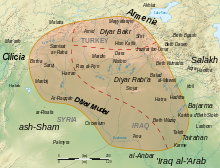Banu Shayban
| Banu Shayban بنو شيبان | |
|---|---|
Arab tribe, a branch of the Banu Bakr. Throughout the early Islamic era, the tribe was settled chiefly in al-Jazira Province and played an important role in its history.
HistoryIn the pre-Islamic period, the Shayban with their flocks wandered according to the seasons, wintering in Jadiyya in the Najd and moving to the fertile lowlands around the Euphrates for the summer, ranging from Upper Mesopotamia in the north to Lower Mesopotamia and the shores of the Persian Gulf.[1] Its chief opponents during this time were the Taghlib and Banu Tamim. Already from pre-Islamic times, the tribe was "celebrated ... for the remarkable quality of its poets, its use of a very pure form of Arabic language and its fighting ardour" (Th. Bianquis), a reputation its members retained into the Islamic period, when histories remark both on their own skills as, and on their patronage of, poets.[1] During the time of  During the Umayyad Caliphate, the Shayban remained powerful in al-Jazira. Shabib ibn Yazid al-Shaybani was able to raise a large-scale revolt by the Najdat Kharijites in the 690s against al-Hajjaj ibn Yusuf, as did the Kharijite revolt led by al-Dahhak ibn Qays al-Shaybani in 745–746.[1] Under the early Abbasid Caliphate, the most prominent Shaybani were the family of Ma'n ibn Za'ida al-Shaybani, a former Umayyad servant who secured the pardon of al-Mansur. His sons and especially his nephews, Yazid ibn Mazyad al-Shaybani and Ahmad ibn Mazyad al-Shaybani, occupied high offices.[1][3] Yazid ibn Mazyad served Caliph Shirvanshah) until 1027.[4]
Another successful Shaybani line was that of The Shayban as a whole are not frequently mentioned in the later centuries, as opposed to its many sub-tribes or splinter groups originating from it. But still Arabs from the Diyar Bakr region in Turkey are tracing their tribal origins back to this tribe. Some families are even claiming descendant from the famous Isa ibn al-Shaykh al-Shaybani line. However the Banu Shayban of Southeastern Anatolia are organized loose and they do not have a Sheikh as a head of their tribe, like it is common in Arab countries. ReferencesSources
|
